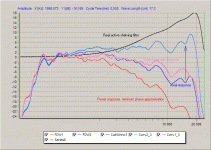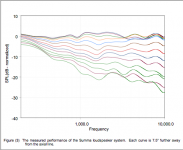Dear Patrick,
I didn't say it is CD or better in this area 🙂 Can you explain CD? Dr Geddes wrote on AES paper that diffraction horns have +5dB aberrations on frequency response. Keep in mind we talk here about cheapest solution of an unplugged tweeter 🙂 I published power response (red) in this thread:
http://www.diyaudio.com/forums/showthread.php?postid=1371060#post1371060
(it's raw Tractrix response without shelving filter)
I didn't say it is CD or better in this area 🙂 Can you explain CD? Dr Geddes wrote on AES paper that diffraction horns have +5dB aberrations on frequency response. Keep in mind we talk here about cheapest solution of an unplugged tweeter 🙂 I published power response (red) in this thread:
http://www.diyaudio.com/forums/showthread.php?postid=1371060#post1371060
(it's raw Tractrix response without shelving filter)
jzagaja said:Dear Patrick,
I didn't say it is CD or better in this area 🙂 Can you explain CD? Dr Geddes wrote on AES paper that diffraction horns have +5dB aberrations on frequency response. Keep in mind we talk here about cheapest solution of an unplugged tweeter 🙂 I published power response (red) in this thread:
http://www.diyaudio.com/forums/showthread.php?postid=1371060#post1371060
(it's raw Tractrix response without shelving filter)
Didn't mean to jump on you, but I've personally built tractrix horns, and they sound weird even when they measure flat on axis.
Here's why this is the case. A tractrix horn focuses it's energy into a narrow beam as the frequency gets higher. So if you have flat on-axis response, the power response is a mess.
A CD horn, or better yet, a OS waveguide is different. They do not focus the treble energy into a narrow beam. The coverage is constant independent of frequency.
There IS a downside however; you must use generous amounts of frequency shaping to bring up the treble. But who cares? Amplifier power is cheap, and compression drivers have efficiency to burn.
jzagaja said:Dear Patrick,
I see more highs on Summa polar response. Here's my horn with filter. I don't see weird power response, do you see?
Are you using horns in your playback?
The pic you attached displays the behavior I expected.
Because you are using a tractrix horn, the sound is focused into a narrow beam at high frequencies. You can see this in your plot, as the response falls off dramatically as you move off axis.
Attached is an example of superb power response. It's from gedlee.com.
In the attached pic, you'll note that the response falls off very very gradually as you move off axis. More importantly, the off axis response is consistent with the on-axis response; you don't see any dips or nulls as you move off axis.
As the frequency approaches 1khz the off axis level grows higher, as the waveguide used in that speaker only maintains directivity control down to 900hz.
At that point another mechanism comes into play, but you'll have to read the pdf for that piece.
Attachments
That's clear, one question left - does OS waveguide maintains CD under suboptimal throat loading like dome tweeter without phase plug.
jzagaja said:That's clear, one question left - does OS waveguide maintains CD under suboptimal throat loading like dome tweeter without phase plug.
How could it? It's physically impossible to do this above a certain frequency. The wavelengths being produced by the dome are shorter than the diameter of the piston.
This applies to all drivers, but is particularly significant with tweeters, since the wavelengths are so short.
This subject has been debated to death on here, take a look at the archives for more.
Stick with compression drivers on waveguides, dome's are far from optimal.
This looks like "Controlled Directivity" instead of the misleading term "Constant Directivity". At least I finally know what is actually being referred to after looking at this pic.Patrick Bateman said:
The pic you attached displays the behavior I expected.
Because you are using a tractrix horn, the sound is focused into a narrow beam at high frequencies. You can see this in your plot, as the response falls off dramatically as you move off axis.
Attached is an example of superb power response. It's from gedlee.com.
In the attached pic, you'll note that the response falls off very very gradually as you move off axis. More importantly, the off axis response is consistent with the on-axis response; you don't see any dips or nulls as you move off axis.
As the frequency approaches 1khz the off axis level grows higher, as the waveguide used in that speaker only maintains directivity control down to 900hz.
At that point another mechanism comes into play, but you'll have to read the pdf for that piece.
Patrick
Those are rather old polars. There have been some recent improvements - if the Thai systems ever get back into production.
I will say that I have little experince with horn loaded domes, and as Patrick says, I don't see the point. In the big picture the compression driver is a small expense (less that the cost of the crossover components!), and not much different than a decent dome tweeter, but a whole lot better performance. So yes, the dome is "sub-optimal" as stated, but what's the point of bothering with "sub-optimal? I'm certainly not going to.
I don't ever recal stating a number for "diffraction horns". How did diffraction horns ever enter into this discussion anyways?
Those are rather old polars. There have been some recent improvements - if the Thai systems ever get back into production.
I will say that I have little experince with horn loaded domes, and as Patrick says, I don't see the point. In the big picture the compression driver is a small expense (less that the cost of the crossover components!), and not much different than a decent dome tweeter, but a whole lot better performance. So yes, the dome is "sub-optimal" as stated, but what's the point of bothering with "sub-optimal? I'm certainly not going to.
I don't ever recal stating a number for "diffraction horns". How did diffraction horns ever enter into this discussion anyways?
compression driver is a small expense (less that the cost of the crossover components!)
Let me disagree. Active subtractive crossover consist two double opamps OPA2132 (4$) plus virtual ground (2$), some caps and resistors (2$), pcb and solvent (3$), switching amplifier (36$), power supply (15$), total cost 62$. BC DE25 driver pair 432$, standard very high quality dome Peerless HDS pair 120$ so total cost with crossover is 120+2*62=244$.
jzagaja said:
Let me disagree. Active subtractive crossover consist two double opamps OPA2132 (4$) plus virtual ground (2$), some caps and resistors (2$), pcb and solvent (3$), switching amplifier (36$), power supply (15$), total cost 62$. BC DE25 driver pair 432$, standard very high quality dome Peerless HDS pair 120$ so total cost with crossover is 120+2*62=244$.
Let me disagree, $432 for a B&C DE25 is robbery. While I do get a price break, I have seen them retail for less than $100. I can get a Chinese DE25 copy for $17. A power supply for $15 - you must be joking.
http://www.thomann.de/gb/bc_de_25_16_ohm.htm?partner_id=25293jzagaja said:
Let me disagree. Active subtractive crossover consist two double opamps OPA2132 (4$) plus virtual ground (2$), some caps and resistors (2$), pcb and solvent (3$), switching amplifier (36$), power supply (15$), total cost 62$. BC DE25 driver pair 432$, standard very high quality dome Peerless HDS pair 120$ so total cost with crossover is 120+2*62=244$.
Maybe because the DE25 is out of production the prices are up. I stopped useing it several years ago. I now use the De250. Those, I know, can be gotten a lot cheaper - its $105 at Parts express and thats high. I'll sell them to you at $100.
The DE 250 is 135-145 Euro in Europe these days. The Dollar-to-Euro exchange rate has not reached the market yet. So its hard to compare prices on both sides of the pond.
Rudolf said:The DE 250 is 135-145 Euro in Europe these days. The Dollar-to-Euro exchange rate has not reached the market yet. So its hard to compare prices on both sides of the pond.
Somebody is making a killing at those prices, and I know its not B&C.
Dealer price on those drivers would be about 45 Euro's. Maybe less, they are made in Itally and the US prices reflect an import duty and shipping.
I'll sell them to you at $100
Could you? Partexpress takes 180$ for a package to EU - am I right?
jzagaja said:
Could you? Partexpress takes 180$ for a package to EU - am I right?
I was mostly joking. The shipping costs to the EU would eat up virtually all of the savings. And it makes no sense to ship them here just to ship them back. I would sell them at that price to anyone in North America.
If I were you I would seriously complain about those prices as they are simply ridiculous.
I could get you a good deal if you were to buy a lot of 100.
If you just can't find a reasonable deal in EU let me know and I'll ask the CEO of B&C whats up and if he can find you someplace that they are more reasonable.
But as usual, when you buy in small lots you don't have much leverage.
When horn profile isn't smooth eg. 1"->2" throat adapter, 1mm difference then according to your knowledge should I expect 3dB or even more bump on frequency response?
jzagaja said:When horn profile isn't smooth eg. 1"->2" throat adapter, 1mm difference then according to your knowledge should I expect 3dB or even more bump on frequency response?
I don't know the exact number, but I would never do that. In my work I have found throat matching to be incredibly important. So much so that we found that fiberglass could not hold the dimensional tollerance and we changed the throat to be cast in epoxy after the fiberglass was made. This gives an exact and precise match, which is important.
This is one of the improvments that were made since the data that Patrick has shown above.
I often see "twin peaks" effect (two bumps at high frequencies) when people put dome tweeter into any waveguide.
There's a strong overshot after 200-300us seen on mine and your
horns. Does it is have negative effect on perception?
There's a strong overshot after 200-300us seen on mine and your
horns. Does it is have negative effect on perception?
gedlee said:
I don't know the exact number, but I would never do that. In my work I have found throat matching to be incredibly important. So much so that we found that fiberglass could not hold the dimensional tollerance and we changed the throat to be cast in epoxy after the fiberglass was made. This gives an exact and precise match, which is important.
This is one of the improvments that were made since the data that Patrick has shown above.
Ah, that's interesting. For my waveguides I waste a lot of time with the bondo and the sandpaper, but I can see how that's totally impractical for a production item.
- Home
- Loudspeakers
- Multi-Way
- Geddes on Waveguides

